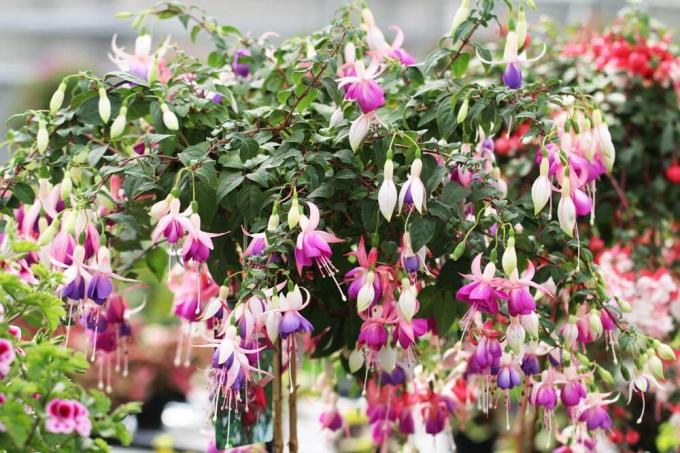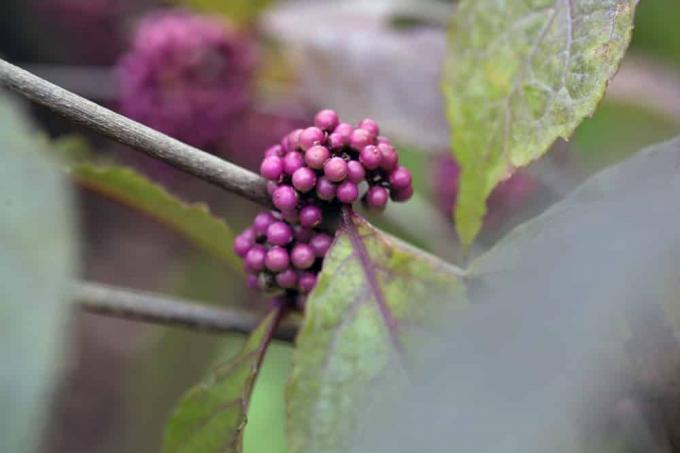

Table of contents
- Location
- Spontaneous self-settlement
- planting
- sowing
- soil condition
- fertilization
- Be careful with the flowers!
- Care in autumn and winter
- pests
- frequently asked Questions
- Worth knowing about the Germander in brief
- Did you know, …
- Care
- Cut
When the first early bloomers in the gardens and meadows delight the eye after the winter, the Germander speedwell (Veronica chamaedrys) with its bright blue flowers to the flowering plants in the garden, which are immediately noticeable by their color. Once the Germander speedwell has found its place in the garden, it is not difficult to take care of this plant because it is quite undemanding. However, there are a few points to be considered with regard to settlement and care, so that the Germander Speedwell can develop its full splendor.
A little information in advance: The Germander Honorary Award is known by many different names. It is also commonly called, among other things, men's loyalty, wild forget-me-not, eyebright or woman's bite and belongs to the plantain family.
Location
If Mannentreu gets a good location, it develops very well. The plant loves a lot of light and sun and does not flower at all in the shade. The Germander speedwell can also thrive in partially shaded places, but it does not bloom as lavishly as in sunny places.
Spontaneous self-settlement
It happens that the Germander speedwell spontaneously settles in a garden by itself because it reproduces both by sowing and by rhizomes and also grows wild in the wild on wall edges, field edges or on Grasslands. Incidentally, Veronica chamaedrys is not only a beautiful flowering plant, but also belongs to the medicinal herbs. The pretty flowers are edible and are used as a tasty decoration in various dishes. If you plant this perennial in your garden, you are also doing the bees a favor, because Germander Speedwell is also a nectar plant.
planting
Normally Germander speedwell is not seeded but planted by dividing the perennials. It is best to plant the divided perennials for the first time in the summer months. About four to five plants per square meter are planted at a distance of 30 to 40 cm. They develop quickly and soon form a dense carpet.
sowing
Like all speedwell species, Veronica chamaedrys can be propagated or replanted by seed. It is important to add enough nutrients to the soil before sowing. The seed comes in the spring on the soil prepared in this way. It is important to know that Speedwell belongs to the light germinators and therefore must not be covered with soil. The seeds should only be gently pressed into the ground. It is then important to also exercise caution when watering so that the seeds are not washed away. Only the following year will the wild forget-me-not so sown begin to flower. But it's worth it, because carpets of flowers of this kind created by seed usually bloom immediately in the coming spring.
Tip:
When laying out the corner with Germander Speedwell, make sure to add color accents with other flowers. Yellow or white crocuses, daffodils, red tulips or small conifers offer a nice contrast to the bright blue carpet of flowers.
soil condition

Veronica chamaedrys is quite undemanding in terms of the soil it needs. However, if possible, the soil should be light, sandy, pH-neutral and not too poor in nutrients. It shouldn't be too dry either. It is therefore important to always water the man-loyal plants sufficiently when it stays dry outside for a long time, so that they remain beautiful and can develop well. However, the plant does not tolerate waterlogging.
fertilization
Germander speedwell likes nutrient-rich soil. Therefore, it should always be provided with enough nutrients. This can be compost, for example, but also horn shavings, guano, bone meal and inorganic ones He tolerates mineral mixtures well and develops his full potential again every year with this diet flowers.
Be careful with the flowers!
When handling men's loyalty, care must be taken that the flowers fall off very easily when touched. That's where the name "Mentreu" comes from. The flowers are therefore not suitable for picking and should be left in peace as far as possible when caring for them.
Care in autumn and winter
Germander Speedwell or Frauenbiss, Mannertreu or whatever it is called from region to region is one of the hardy plants. Normally it even tolerates severe frost. The plants reach a height of between 15 and 30 cm over the summer and can be cut back in autumn so that they will sprout freshly again next spring. To make sure that the small perennials do not die off in winter, you can also protect them with some mulch. But the layer should be light and not too thick so as not to suffocate the tender plants. In the spring, care must be taken to collect the Germander Prize again in good time from this to free the protective layer, because it drives out very early and shows its first radiant flowers as early as April blue flowers.
pests
Germander speedwell can be affected by powdery mildew.
frequently asked Questions
Since Veronica chamaedrys does not grow very tall, it is well suited for planting in front gardens or Rock gardens, but also unfolds its flowers very beautifully in the front areas of perennial beds. In this case, however, it must be ensured that the tall-growing perennials should be accommodated further back.
In any case. Even in the wild, this plant likes to settle on pastures and meadows. It only needs the right soil and enough light and sun, then it often sows itself because insects, ants or the wind carry the seed there. If you have a wild meadow in the garden that is not constantly mowed, Germander Speedwell will also grow well here and be a pleasure to look at.
Worth knowing about the Germander in brief
- The Germander prize is also known under the name of men's loyalty, eyebright or wild forget-me-not.
- The plant is perennial, grows up to 30 cm high and has sky-blue flowers with dark veins.
- The leaves of the plant are ovate and opposite. They are short-stalked or sit directly on the stem.
- The Germander speedwell spreads like a carpet and is a shallow rooter.
- A peculiarity of the Germander speedwell is that the petals fall off very quickly after picking.
- The Germander speedwell quickly forms carpet-like cushions.
- Its flowers are very popular with insects. The flowering period lasts from May to August.
- Unfortunately, the plant is often fought as a weed in gardens, especially when it appears on the lawn.
- Caution: the plant is poisonous!
Did you know, …
that the Germander speedwell is popularly known as a thunderbolt? It used to be believed that it bloomed particularly abundantly in years with a lot of thunderstorms or that picking the plant brought thunderstorms onto the scene. Germander Speedwell used to be used as a medicinal plant for liver, stomach and intestinal diseases.
Care
- The plant needs sun as much as possible. Without sun no flowers form.
- The plant substrate should be medium dry to dry. Light, sandy, neutral, but fertile soil is ideal.
- Germander speedwell is an indicator plant for loose, nitrogen-rich soil.
- Pouring is rather moderate.
- Fertilizers are either organic (compost, horn shavings, bone meal, guano) or inorganic (various minerals) fertilizer
- Do not plant more than 5 plants per square meter as the plant spreads well.
- Cut back in fall and cover with mulch!
- The root ball should be divided every two to three years so that the abundance of flowers is not lost.
- The Germander speedwell is propagated by division in autumn or by half-lignified cuttings from non-flowering shoots.
- Powdery mildew is a common disease.
- Pests are rare.
Cut
- Germander speedwell will be pruned back in the fall.
- On the lawn it will be mowed away anyway.
- Cut off almost to the ground in the bed and cover.
- It is often only cut in the spring, before they sprout.
 garden editorial
garden editorial I write about everything that interests me in my garden.
Learn more about perennial plants

These 15 Flowers Are Hardy & Perennial | bedding plants
Unlike annual flowering plants, perennials come back every year. They stay in one place for many years and play a major role in garden design. Some varieties get through the winter without any problems. We introduce you to 15 hardy perennials.

Cutting & Propagating Cranesbill | 7 Tips for Geranium
As a rule, cranesbills do not necessarily have to be cut. A cut stimulates a second flowering in some species. Other species need a pruning for rejuvenation. With geranium, it always depends on the species. This also applies to propagation.

21 hardy, perennial and flowering plants for balconies and tubs
A beautifully planted balcony is not only a feast for the eyes, but often also a lot of work. This is especially true if you want to enjoy colorful blooms all summer long. Repotting is the order of the day every few weeks.

Sweet William, Dianthus barbatus | 14 tips for care, sowing & overwintering
The decision for carnations is spot on. Like hardly any other plant, they guarantee colorful flowers in abundance. Demanding care requirements are alien to them, which is why we don't have to struggle with work. Sow and just wait, that's almost all.

Lantana, Lantana camara - location, care and propagation
The fascinating play of colors of the lantana appears as if transformed by magic; the popular garden flower, which blooms between May and October, is capable of changing its bloom color! However, optimal care is important so that hobby gardeners can observe the wondrous color change of the lushly blooming rosette.

Beauty fruit varieties and care tips
The beauty fruit is an easy-care shrub, which can grow a few meters in height and enchants with violet fruits. The plant and its various varieties are well suited to local site conditions, but are sensitive to temperatures that are too cold. Therefore, young plants in particular need additional winter protection.



